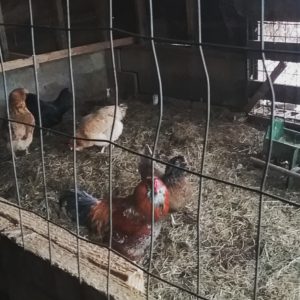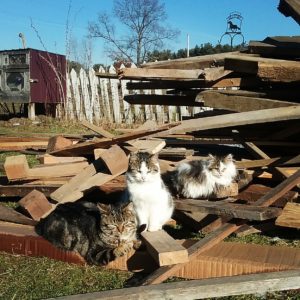I’m very fortunate to live on a beautiful property that has been farmed continuously since just after the Revolutionary War. We tend 50 acres and have a barn that dates to 1894 as well as numerous outbuildings. For those trying to homestead on just a few acres (or less!), this may seem like plenty of space to make homesteading dreams a reality. And it is, but there are times when it’s easy to feel that we don’t have enough space for all the things we are trying to do. Over the 10 years that I have called Pleasant Valley Farm home, I’ve come to realize it’s often not a lack of space, but space that is being used poorly.
The downside to living on a historic farm is that there is often generations of clutter. Sometimes, uncovering this is wonderful bits of history, like the WWII-era newspapers we found when we tore up the linoleum floor upstairs. Often though, it is more like old fence wire, pieces of broken glass and other things that were tucked away during hard times. Farmers are frugal and resourceful, and while I understand the value of having materials on hand to make repairs, a good cleaning is useful as well.
Dan, my husband, grew up on the farm we call home. When I came here, all the outbuildings had a history of use for one thing or another. We have found it very helpful to examine what the buildings were used for, ask if that serves our purpose now, and consider if we can better utilize the space.

Wasted space is now being used to house single-breed flocks of chickens, like our Ameracaunas.
Last spring, I needed additional space to divide my chickens into single-breed flocks for hatching season. The ideal space would have shelter but plenty of room to move for the birds, be easy to access, and ideally, near the other pens. It turned out the ideal location was literally right in front of me. We had been calling it the “sheep house” for years.
We raise Katahdin sheep, so we do need a space for them to take shelter or to set up small pens at lambing time. The sheep house was still serving that purpose. However, our flock is much smaller than the flock Dan’s parents had years ago. While they used the entire building, we were only using the front half. There was a half-wall separating the building into two sections, and the back was not being used. There were some stock tubs and other items stored there because any empty space will collect clutter. But, we were essentially using only half. Cleaning it out was simple, and we used some wire to create a fully enclosed back portion with plenty of light and ventilation. It actually worked so well we are not only using it for poultry again this spring, but we subdivided it into two rear pens. I’ve doubled the number of pens I have for breeding poultry in the spring with minimal expense or effort since we used material left over from other projects and a building that was already there.
This spring, we are doing something similar. Hatching more kinds of poultry means I need more brooder pens. I also wanted to expand my rabbitry, as I really enjoy raising heritage breed Silver Fox rabbits. I already have small stock pens on the outside of a building that has always been called the woodshed. However, the inside of that building was a tangle of lumber, firewood, boxes and more. Things were thrown in haphazardly; it was not possible to walk inside or find anything. While we used part of the back side to store garden tools, most of the space in this building was wasted. It was impossible to tell what was inside or get to much of anything.

Cleaning can be a big task, but in this case, it also meant lots of raw materials for our planned project.
It was a major project to clean out the woodshed, which was the first step to making it a productive space again. Any lumber that could be useful was piled in the yard. After cleaning, much of that lumber was recycled into five spacious pens I can use for my rabbits. They are actually big enough to temporarily house even a goose or turkey, which is handy. The pens are out of the wind and sun, but close to the other rabbit and chick pens which makes doing chores easier. The pens are painted, which means it looks nice and it’s not obvious that it was made from different types of lumber. I’m also really excited about painting a stripe of blackboard paint on all the doors. I already had an open can of blackboard paint, and I can now easily keep track of what/who is in each pen. I can record important dates like breeding date, birthdate, or hatching date so those records are in front of me and not something I have to go inside and look up.
The back of the woodshed was cleaned as well, creating a bigger, more organized space for tools, equipment, and supplies for the garden. Again, we used an existing building and a good amount of reclaimed supplies. The investment was fairly minimal. It took more time than anything, which was why it was a great project to start in late winter when there were not a lot of other pressing projects.
In both cases, we have created useful spaces that make our business work better. Decades of clutter can be a big obstacle to reforming a space. However, I think the bigger obstacle is rethinking what that space could be. Many times, the name of a building is often rooted in what it was used for when it was built. Don’t be afraid to reimagine those spaces. Your homestead is uniquely your own. It is different in some ways than any other homestead, even if it is the same property. I’m sure you have dreams of what you want to do and what the perfect space would look like. With those in mind, it’s a great idea to look critically at the space you already have and identify the places that you’re not using as well as you could.











1 Comment
Don’t forget about all the space on top of the sheep pen, or should I say space 4 feet up from the floor, you know if you run some boards across a section of the barn and now the birds have all that space on the “second floor”. Just saying you could have many levels if you think vertical.